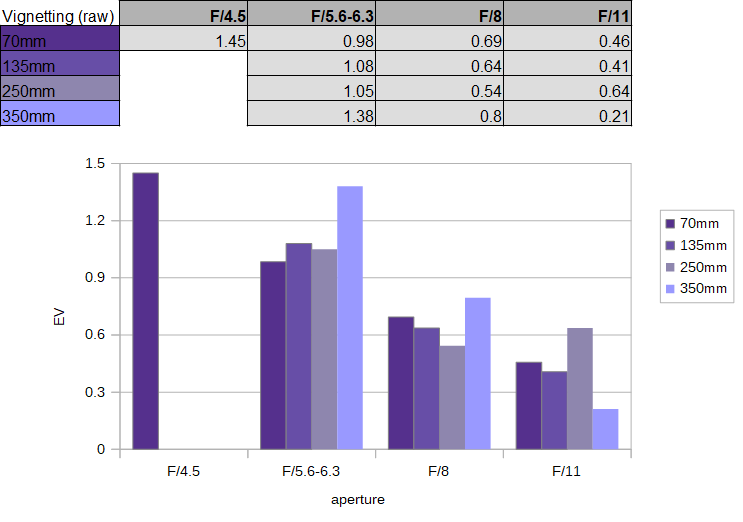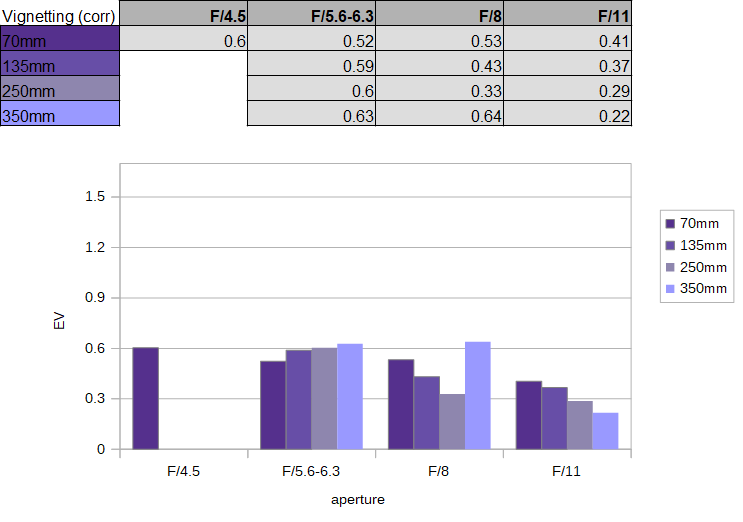|
Sony E 70-350mm f/4.5-6.3 G OSS - Review / Test Report - Analysis |
|
Lens Reviews -
Sony Alpha/NEX (APS-C)
|
|
Page 2 of 3

Distortion
The Sony E 70-350mm f/4.5-6.3 G OSS has two souls with respect to image distortions.
The raw optical characteristic is hardly impressive ... in the positive sense at least. RAW images exhibit massive pincushion distortions throughout most of the range with a peak of 3.8% at 135mm. If you are shooting wildlife, this may not matter but for images with straight lines, you should better stick to image auto-correction.
With activated image auto-correction, the distortions are perfectly corrected as you can see below.
Vignetting
The Sony lens is a dedicated APS-C design. Due to the smaller image circle, it produces more vignetting compared to full format lenses when on an APS-C camera.
At maximum aperture, the original light falloff is around ~1.4EV at the extreme ends of the zoom range - this will be visible in some scenes. Stopping down to f/8 helps to reduce this to a more manageable degree.
 However, activated image auto-correction comes to the rescue once again here, and usually, you won't notice any significant light-falloff at any setting. Remember that vignetting correction comes at the expense of higher corner noise due to the required signal amplification.
However, activated image auto-correction comes to the rescue once again here, and usually, you won't notice any significant light-falloff at any setting. Remember that vignetting correction comes at the expense of higher corner noise due to the required signal amplification.

MTF (resolution)
As far as resolution is concerned, the Sony E 70-350mm f/4.5-6.3 G OSS delivers good to very good quality. Unsurprisingly, the performance is best in the lower portion of the zoom range. The image center is very good to excellent here and the border/corners are also very sharp at the relevant aperture settings. There's a slight drop in quality at the 250mm setting but it's still very sharp overall. The situation changes somewhat at 350mm. The quality in the image center is reduced albeit still decent whereas the outer image field softens. It's best to stop down to f/8 for squeezing out the best quality here.
The field curvature is generally low. The centering quality of the tested sample was good.
Please note that the MTF results are not directly comparable across the different systems!
Below is a simplified summary of the formal findings. The chart shows line widths per picture height (LW/PH) which can be taken as a measure for sharpness.
If you want to know more about the MTF50 figures you may check out the corresponding Imatest Explanations

Chromatic Aberrations (CAs)
Lateral CAs (color shadows at the image borders) are very low between 70mm and 250mm. They can be visible at 350mm with an average pixel width around 1px at the image borders but that's still pretty good in the grand scheme of things. Image auto-correction will deal with this and it's mostly a lossless correction here.

Bokeh
Given its moderate max. aperture, the Sony lens is not a bokeh monster. However, the focal length range is certainly long enough for isolating objects with a decent amount of surrounding blur so let's see what it can do for you here.
Out-of-focus highlights show a rather busy inner zone and there's also some outlining. This is less than ideal, of course. Furthermore, the shape of the discs starts to reflect the more edgy aperture shape at f/8 but it's not too obvious - unlike at f/11. Unfortunately, it shows that the aperture mechanism consists of 7 blades only. That being said, if you are up to bokeh-style images, you will probably shoot at maximum aperture with this lens anyway.
 The shape of the highlights tends to deteriorate towards the image borders - this is due to mechanical vignetting. As you can see below (images were taken at ~135mm), the discs have a "cat-eye" shape at f/5.6. Stopping down changes the shape and the corner discs are restored to a rounder shape at f/11.
The general rendition in the focus transition zones is very smooth in the background (to the left below). However, it shows very pronounced double-edges (nisen bokeh) in the foreground resulting in a quite nervous rendering.
The shape of the highlights tends to deteriorate towards the image borders - this is due to mechanical vignetting. As you can see below (images were taken at ~135mm), the discs have a "cat-eye" shape at f/5.6. Stopping down changes the shape and the corner discs are restored to a rounder shape at f/11.
The general rendition in the focus transition zones is very smooth in the background (to the left below). However, it shows very pronounced double-edges (nisen bokeh) in the foreground resulting in a quite nervous rendering.

|